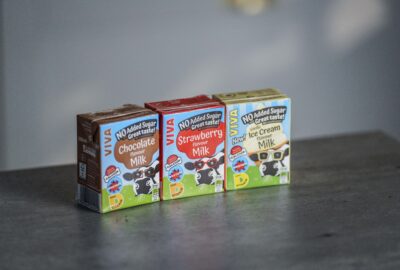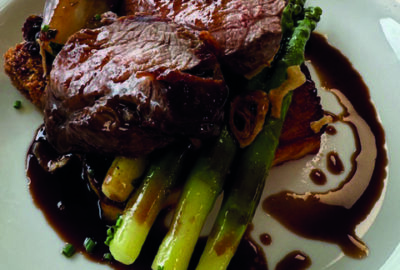Although stringent cleaning and health and safety practices are part of everyday life for caterers and chefs across all areas of foodservice, never before has there been such a public focus on hygiene.
For this feature, we have focused on some of the best hygiene innovations and ideas implemented by operators over the past few months as caterers look forward to reopening their doors over the coming months.
Redesigning Spaces
One of the biggest changes to in-house dining environments has been to accommodate changing social distancing regulations over the past year. The creativity shown by operators when carving out socially distanced floorplans to achieve a balance between maximising covers and complying with regulations has been impressive. Italian based Goga Caffe went so far as to build plexiglass partitions, surrounding guests on tables for two on three sides, resulting in a loss of only four covers. The investment included printing graphics on the plexiglass to create more intimate spaces for diners.
French designer Christophe Gernigon introduced a concept with a similar result that can be applied to tables of any size.
His suspended plexiglass hoods (which have been trialled at the H.A.N.D restaurant in Paris since May 2020) which are shaped like large lampshades and are positioned above each guest. Simple to set up, take apart, clean and disinfect. They surround diners on three sides to reduce the risk of airborne infection without obscuring their view of the restaurant’s environment.
This constant stream of innovation has not only been restricted to in-house dining. In Japan, a railway station delivery service introduced new packaging for their food-to-go boxes, featuring a lid which folds to form a shield on three sides of the takeaway carton, keeping airborne droplets from passengers away from the food.
Managing Menus
Undoubtedly one of the key elements of any restaurant, café or catering service is providing access to a menu. Many operators have switched to single use menus to make table service more efficient and reduce the amount of wiping and sanitising required, but there are other solutions. Most businesses are running a reduced menu to facilitate social distancing in the kitchen, so converting walls into blackboards, projecting your menu onto a wall or printing on plexiglass screens could help to reduce waste and consumer touchpoints.
If you are wrapping cutlery in a paper bag, consider printing your menu on the wrapper so it serves a dual purpose, or for those who prefer a more technology-based approach, invite customers to download your menu to their mobile phone using a QR code. The more advanced method however is to encourage guests to download and use an app to access the menu, place their order and pay the bill. Whilst there are strong marketing advantages to mobile apps, they can be expensive to develop and are not suitable for everyone.
David Bone, Foodservice Channel Manager for Weetabix told us “We have seen a significant increase in demand for portion packs in the past few months, with hospital and school caterers looking for convenient ways to meet food needs for patients and pupils. Weetabix Original is a low sugar cereal, made with 100% wholegrain and fortified with vitamins to help set you up to take on the day. It is now available in x 1 and x 2 biscuit packs, while portion packs are also available for Ready brek and Alpen Original, as well as Alpen Bars and Weetabix On The Go breakfast drinks.”
In the Kitchen
Stringent hygiene and food safety standards should always be followed by operators, however there are some tasks that are often overlooked or more difficult to achieve due to time and lack of knowledge or training. ConvoClean by Welbilt was designed to help overcome one such task by minimising the difficulty, risk and time taken to clean catering ovens. Featuring a formula with low foam properties for self-cleaning ovens, it is fully certified for unattended cleaning, so it can run after the kitchen has closed, ready for use the following day.
To aid social distancing measures in kitchens, we have seen operators introduce portable workstations with wheels and brakes which help back of house staff instantly rearrange the kitchen to cater for breakfast, lunch and dinner service as well as the introduction of one-way systems and floor markings to create individual work zones.
To ease the washing up area in large kitchens, Wexiödisk’s PRM and sorting units are helping to support social distancing measures by eradicating the need for pre-rinsing/sorting by hand. Once the kitchen porter has loaded the dishes into the rack, they can be pushed into the PRM which automatically starts a pre-rinsing process before cleaning commences. The cleaned dishes are dispensed from a separate area, preventing the need for a single person to keep switching between the clean and dirty side of the washing area, minimising the risk of cross contamination.
It’s Time to Make the Invisible, Visible
With consumer anxiety around hygiene at an all-time high, making cleaning processes that were previously undertaken discreetly, visible to guests will help to instil consumer confidence as we creep back to normality. Publicising the efforts you are making to ensure your environment is safe and that your employees are well versed on regulations and new procedures has never been a consideration in the past, but in this new world we find ourselves in, it is increasingly important.
Hotel chains such as the Hyatt, Marriott and Hilton have posted videos online, informing guests of their hygiene practices in place throughout their accommodation and restaurants so they know what to expect, whereas staff at the Omni Hotels & Resorts in the USA wear “I’m Cool” stickers, indicating that their temperatures have been taken when they arrived at work. Although this wouldn’t catch an asymptomatic case, it gives guests a bit more confidence that the staff are being regularly monitored in a playful way.
The pandemic has completely transformed the way consumers behave in every day life from wearing masks while visiting shops or restaurants to utilising hand sanitiser regularly as a now standard part of life. 68% of consumers believe that handwashing is the most important protection against COVID-19 so it’s important to help give your customers, pupils and residents confidence with visible hygiene practices and recognisable sanitisers such as Lifebuoy.
Alcohol content is the most important factor when choosing a hand sanitiser with seven in 10 consumers saying they would want to see at least 60% alcohol content. Formulated with over 70% alcohol, Lifebuoy hand gel has a quick drying, non-sticky formula that effectively fights germs and protects from bacteria, making it ideal for both front and back of house. Unlike a liquid product, the gel texture of our range allows a controlled dosage and therefore more efficiency on the palm by limiting the risk of spillage. Through the use of branded point of sale including posters and stickers to dispensers you can assure your customers and staff that you are using the best quality branded products to keep them safe.
The more you can make consumers aware of what you are doing the better, and if you can ask customers for feedback to drive continual improvement, you will build consumer confidence in your brand. The importance placed on communicating how seriously your business is taking hygiene at this moment in time cannot be underestimated – it’s certainly a strange world indeed when promoting hygiene procedures become the ultimate marketing tool!
Fed up with wet work surfaces after wiping them down? Try a dry-touch sanitising product which can be used as an airborne room spray or on hard surfaces such as tables, light switches and handles.
Make hygiene training consistent and accessible through the use of online learning management systems which make comprehensive and consistent training materials available to staff at any time. Chains such as RIU Hotels and Resorts in Germany have delivered over 22,000 hours of training in the prevention of COVID-19. This practise can also be adopted by smaller businesses, using one of the many online animation tools to create your own videos, hosting them on a YouTube account and producing updates as and when required.


